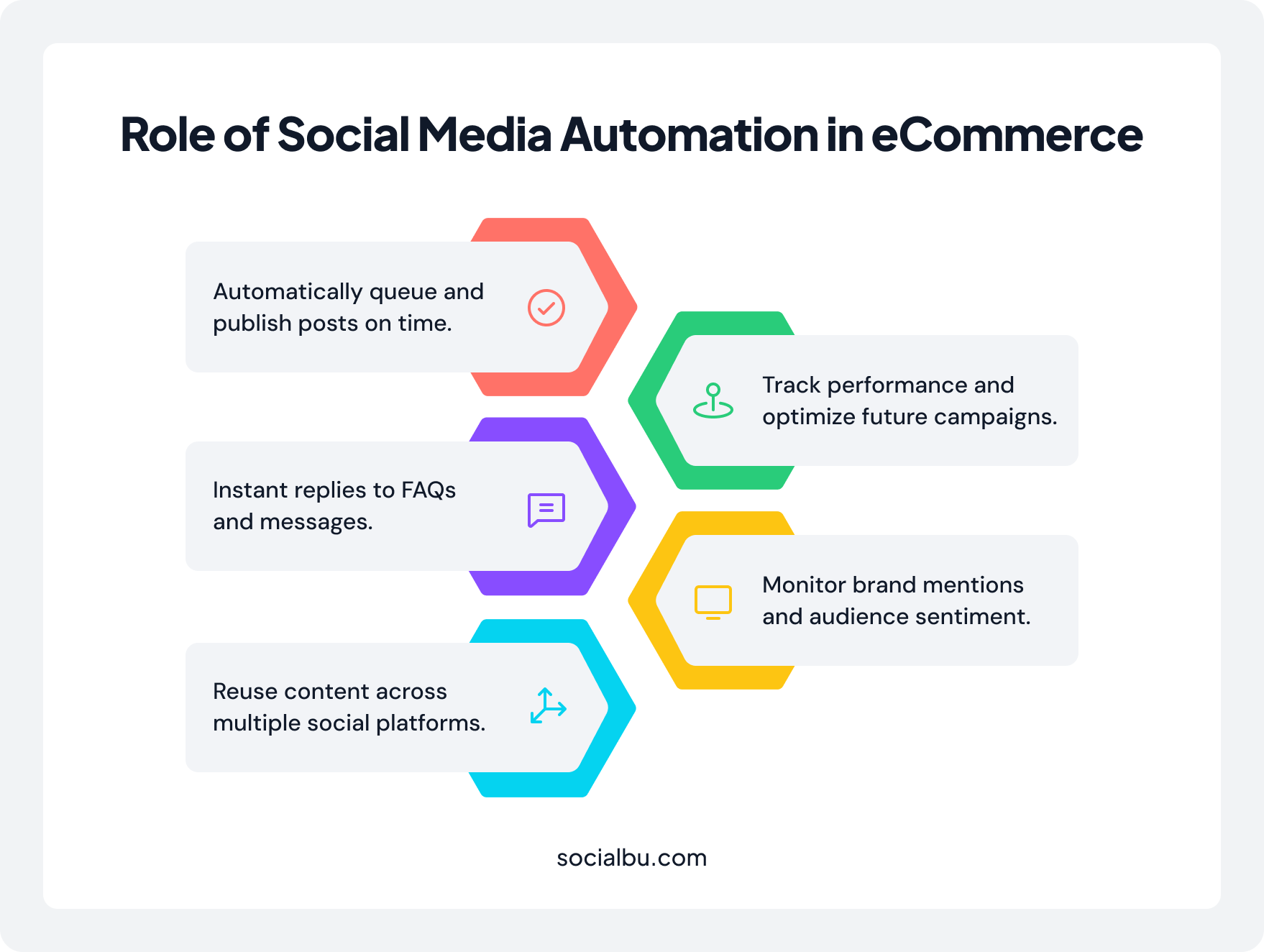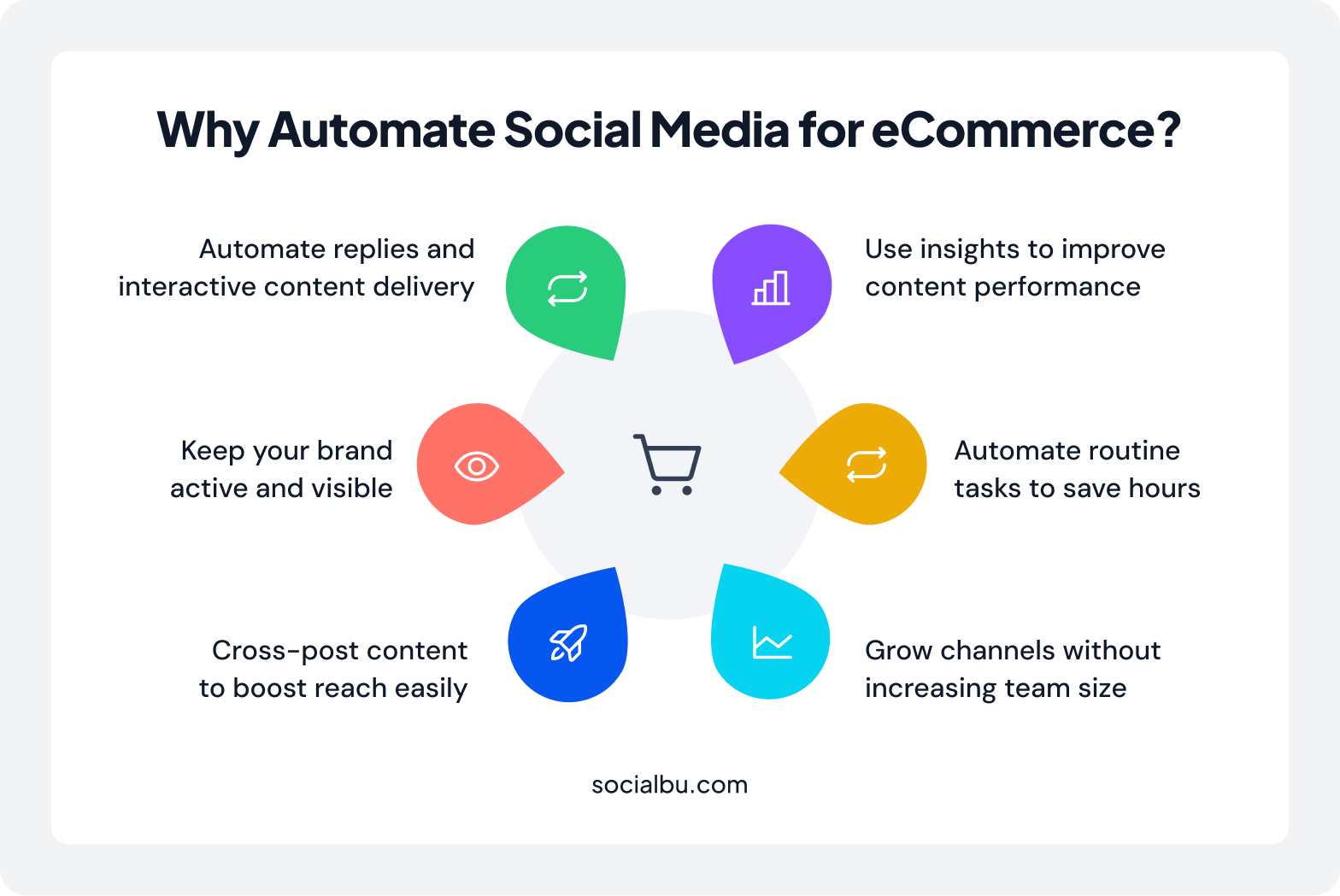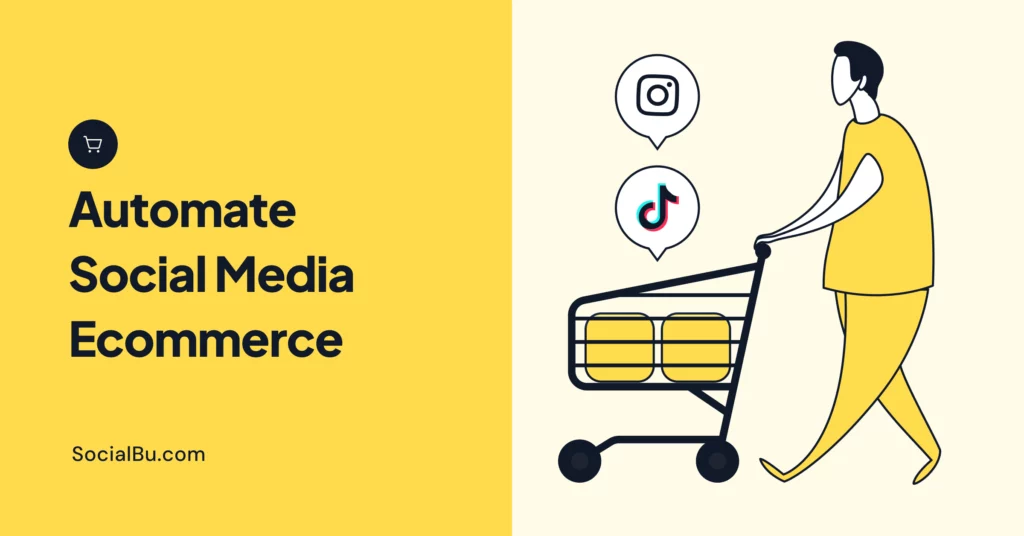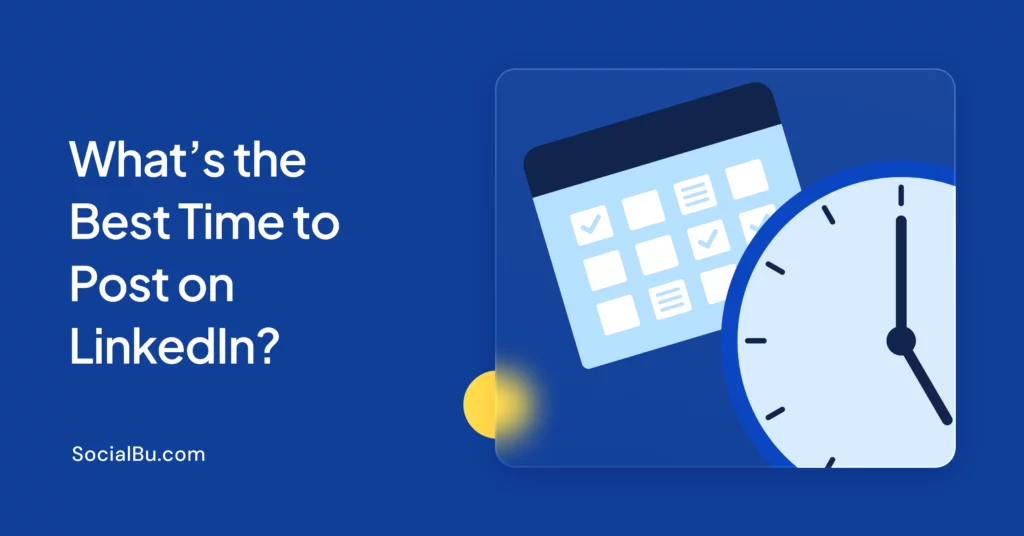When you automate social media ecommerce, it means using tools and smart workflows to automate marketing tasks such as scheduling posts, engaging customers, and analyzing performance without manual effort.
In 2025, roughly 5.31 billion people use social networks, and U.S. social commerce sales are set to reach $80 billion, accounting for nearly 17% of online purchases. Small teams can automate social media ecommerce by batching posts, deploying chatbots, and using a content calendar to post across Instagram, Facebook, and TikTok at once.
When you automate social media for ecommerce, you free your team from repetitive work and focus on growth.
In this full guide, we’ll walk you through each step, from planning your automated workflow and choosing the best tools to leveraging AI and measuring success. So you can streamline e-commerce, social media automation, and drive more sales.
Social Media Automation and Its Role in E-commerce?

Social media automation simply uses software and tools to run parts of your social marketing automatically. Instead of manually posting every tweet or checking each comment, automation handles routine work in the background.
In practice, it covers things like scheduling content, sending quick replies, and gathering data so you only step in when creativity or human judgment is needed.
Key types of automation tools include:
- Post Scheduling
- Chatbots and Auto-Responders
- Content Repurposing and Publishing
- Reporting and Analytics
- Social Listening
Together, these automated functions fit the e-commerce model by handling multi-channel marketing needs and pain points. E-commerce sellers often juggle multiple social storefronts, including Facebook Shop, Instagram Shop, and marketplace channels, as well as various campaigns. This marketing automation lets them manage everything in one place.
Why Should You Automate Social Media for eCommerce?
From automated social media marketing for online stores to AI-powered ads, automation is reshaping how brands grow online. Here’s why you should automate social media ecommerce:
Save Time and Resources
- Replaces repetitive tasks like daily posting and content updates.
- Brands save 6+ hours a week. That’s over 300 hours per year.
- Ideal for small teams that need to do more with less.
- Nearly 47% of small businesses already use marketing automation for social media.
Consistent Branding
- Post scheduling tools ensure that your feed is active even on weekends.
- Builds trust and improves visibility.
- Nearly half of consumers now engage with brands more on social media than they did 6 months ago.
- Automation helps you publish regular product promotions, UGC, and seasonal content.
Reach More People Across Platforms
- The average person uses 6.8 social networks monthly.
- You can cross-post easily to Facebook, Instagram, TikTok, Pinterest, and more with automation.
- Tools allow you to schedule multi-platform campaigns and automatically repurpose content for each channel.
- For example, a single message like a flash sale can be shared on all platforms instantly.
Data-Driven Strategy
- Automated tools offer real-time insights and reports.
- See which post, platform, or product drives the most clicks or sales.
- Helps you fine-tune your strategy and ad spend.
Pro Tip: Adopt proven social media automation strategies for ecommerce stores, like drip campaigns or UGC reposting.
Boost Engagement and Customer Service
- Boost ecommerce engagement with automated posts like polls, Stories, and offers.
- Chatbots handle FAQs like shipping, sizing, and order status 24/7.
- 64% of customers expect a reply within one day, and automation helps meet that demand.
- Automating customer service in digital marketing helps you stay responsive without hiring more staff.
Scale Easily and Maximize ROI
- You can add more platforms without growing your team.
- Tools handle publishing, replying, and reporting so you can focus on creative work.
- Boosts your return on investment by reducing manual effort.
- Great for growing brands that need to automate social media for ecommerce at scale.

Planning Your Automated Workflow
Building an automated social media ecommerce strategy starts with a clear roadmap. Begin by defining your content pillars and campaign themes, such as product launches, promotions, user-generated content, and educational posts.
Content Calendar Creation
Create an automated content calendar for e-commerce, such as a spreadsheet or digital planner, that outlines what you will post, when, and on which channels. This calendar should cover daily, weekly, and monthly goals. Align that frequency with your capacity and audience habits.
Once the calendar framework is set, plan the workflow. Brainstorm post ideas, assign creation tasks (such as writing copy, designing graphics, or shooting videos), and schedule each piece accordingly.
Workflow Steps
Here’s how to automate social media posts for ecommerce brands in simple steps.
- Use automation tools like SocialBu to schedule posts in advance (see “Tools” section below). For example, you might reserve Mondays for new products, midweek for tips, and Fridays for user spotlights.
- After scheduling, don’t forget to review and optimize your settings.
- Establish a routine (biweekly or monthly) to review which posts performed best and refine your upcoming content.
Documentation and Organization
Documentation always pays off. A study by Sprout Social found that 64% of high-performing companies utilize a written content strategy, which includes a publishing calendar. A digital planner or checklist can keep you organized.
In practice, planning your automated workflow might involve setting reminders to batch-create content one week in advance, uploading it in bulk (via CSV or drag-and-drop interfaces), and then letting the scheduler publish it at optimal times.
Review and Optimization
Finally, loop in reporting. Mark milestones to review analytics and adjust your strategy. For example, test posting times and use the data to tweak the calendar. By methodically planning, creating, scheduling, and reviewing content each cycle, you’ll ensure your social presence stays consistent and engaging.
Tools and AI-Powered Automation Platforms
It is essential to select the most effective tools to automate social media for e-commerce. E-commerce social media teams require robust tools to keep pace with the high volume. Leading e-commerce social media automation tools help with scheduling, analytics, and even AI-driven features.
SocialBu
It is a unified platform that offers post scheduling (including bulk CSV import), RSS auto-posting, automated replies, and advanced analytics. SocialBu users cite simplified queue scheduling and bulk uploads as big time-savers. Its CSV importer makes it simple to bulk schedule ecommerce product updates.

Other Tools
Besides SocialBu, some other popular tools are mentioned below:
Hootsuite
Hootsuite helps you automate social media for ecommerce by scheduling posts in bulk and managing multiple accounts in one place. It also suggests the best times to post using built-in analytics.
Buffer
Buffer makes it easy to schedule and publish posts automatically across all major platforms. It’s a great option to streamline e-commerce marketing with automation for small teams.
Sprout Social
Sprout Social supports ecommerce marketing automation for social media with smart scheduling, content approvals, and auto-generated performance reports. It also helps you manage comments and messages efficiently.
Sendible
Sendible lets you plan, queue, and bulk schedule ecommerce product updates with ease. It also automates content from blogs or RSS feeds to your social channels, saving time.
Each tool has strengths:
- SocialBu’s built-in AI assistants for caption writing and post generation
- Buffer’s streamlined interface and custom posts per channel
- Hootsuite’s robust reporting and ad integration
- Sprout’s excellent engagement tracking
- Kontentino’s collaborative workflow and best-time suggestions
Tools for AI Automation
On the AI side, tools are emerging to generate and adapt content. For example:
- ContentStudio or Lately uses AI to rewrite posts or suggest hashtags.
- AI chatbots, such as Tidio or MobileMonkey, integrate with Facebook Messenger or web chat, automatically responding to FAQs and sales inquiries.
- Chatbots can significantly accelerate customer interactions. By 2025, chatbots are projected to save businesses ~2.5 billion work hours, and 64% of consumers appreciate their 24/7 availability.
- In practical terms, an e-commerce brand might use SocialBu’s AI Caption Generator to create product descriptions automatically, then integrate a chatbot to answer customer queries on social media around the clock.
Tools for Reporting and Optimization
Look for tools that offer post-performance tracking and A/B testing support for enhanced reporting and optimization. For example, SocialBu lets you compare metrics across posts and channels. Many platforms also integrate with Google Analytics and Shopify, letting you tie social campaigns back to web traffic and sales.
Look for automation tools for e-commerce content marketing that cover scheduling, analytics, and AI copy. When choosing a tool, consider the following things:
- Scheduling (does it support all your networks?)
- Automation (auto-post from RSS or blog feeds, drip rules)
- AI capabilities (content generation, auto-replies)
- Analytics (follower growth, engagement, conversions).
Ultimately, the best fit depends on your scale and budget. SocialBu offers built-in ecommerce integrations through Pabbly Connect and workflows at competitive pricing. Regardless of choice, these tools streamline and scale social media management, turning hours of manual posting into automated, data-driven processes.
AI Workflows in eCommerce Social
Artificial intelligence enables the automation of social media and e-commerce tasks, freeing up your time. By adding AI into your ecommerce marketing automation for social media, you can deliver the right message to each shopper, create fresh visuals fast, and watch trends in real time.
Content Personalization
AI can drive dynamic product ads and product promotions based on customer behavior. For example, returning buyers see accessories tied to past purchases, while new visitors get welcome offers. This type of AI-driven social media automation for online stores can increase click-through rates by up to 47% and boost sales because each ad feels more personal.
Creative Generation
Instead of designing every image or video from scratch, use AI to transform a single product photo into multiple formats, such as banners, short clips, or carousel posts. AI tools also suggest captions and hashtags for each network. This e-commerce workflow automation for social content keeps your channels fresh without extra work from your design or writing teams.
Smart Analytics and Insights
With AI-powered post-performance tracking, you skip manual reports. Automated dashboards show which posts get the most likes, shares, or clicks. Smart scheduling then selects the optimal times to post, based on past engagement. AI sentiment analysis scans comments and messages for praise or issues, so you can step in when it matters.
If you’re wondering how to use AI to schedule social posts, many tools like SocialBu offer smart scheduling that picks the best time based on past engagement.
Social Listening and Trend Alerts
AI-driven social listening tools monitor mentions of your brand, competitors, or key topics around the clock. You receive real-time alerts if a popular influencer mentions your product or a customer reports an issue.
This feeds into your customer journey automation, triggering follow-up messages, special offers, or restock notifications all on autopilot.
By using AI for personalization, creative work, analytics, and listening, you truly automate social media ecommerce at scale. Your team spends less time on routine tasks and more on growing your brand.
Platform-Specific Automation Strategies
Each network needs its own approach to automate social media ecommerce:
Meta (Facebook and Instagram)
- Automate Instagram and Facebook posts for ecommerce using Meta Business Suite or SocialBu’s scheduler.
- With Meta Business Suite, you can automate Facebook Shop posts by syncing your catalog and scheduling product highlights in advance.
- Set up automated Messenger replies or FAQ bots to instantly answer customer questions.
- Enable Shops/Instagram Shopping and sync your Shopify feed for dynamic product ads and product promotions. This is your gateway to automated social selling for ecommerce businesses.
- Use Creator Studio insights or Meta’s AI-driven ad targeting to boost reach.
TikTok
- Use built-in schedulers or third-party TikTok automation tools for e-commerce like SocialBu or Loomly to plan videos in advance and cross-promote them across platforms.
- Use trend tools like TikTok’s Creative Center for top hashtags and sounds.
- Experiment with TikTok Shopping to enable users to make purchases directly within the app.
- Automate repurposing vertical videos to Reels or Shorts for extra reach.
- 37.8M U.S. users shopped via TikTok.
- Use the native scheduler or SocialBu for Pinterest automation for e-commerce and set up Pins in advance providing ecommerce social media scheduling solutions.
- Convert your catalog into Rich Pins and Product Pins to automatically display prices and stock information.
- Automate keyword and hashtag insertion for better Pinterest SEO.
Other Platforms
- LinkedIn: Schedule B2B posts and run automated Ads for wholesale or supply brands.
- Twitter/X: Queue tweets, use saved lists, and set up auto-replies for support.
- YouTube: Schedule premieres and auto-crosspost Shorts.
Use LinkedIn or Twitter auto-posting to drive B2B leads. It is an example of ecommerce posting automation for sales and engagement.
By adjusting each platform’s automation features, you ensure smoother social media post automation for Shopify and more consistent social commerce results.
Measuring Success and Optimization
Automating social media ecommerce isn’t a set-and-forget process. You need to track results and adapt.
Key Metrics
Utilize post-performance tracking to monitor engagement rates, click-through rates to product pages, conversion rates, and follower growth. Don’t forget to track your social media retargeting for online stores, especially ads shown to users who clicked but didn’t purchase.
Automated Reports
Schedule weekly or monthly auto-generated dashboards. Utilize these e-commerce workflow automation tools for social content reports to refine posting times and content types.
A/B Testing
Automate split tests for captions, images, or call-to-action (CTA) elements. Let the tool show which variant resonates most.
ROI
Tie every automated campaign back to sales and signups. Track cost-per-acquisition and overall return, especially as social ad spend grows approximately 9% annually, so you know your social media post automation for Shopify truly pays off. Track the ROI of retargeting via social media to see which ads pull the best results.
Note: Apps like Outfy support automated Shopify marketing via social media, helping you schedule posts the moment a product is added or tagged in Shopify.
Best Practices and Tips
To streamline ecommerce workflow automation for social content, keep these tips in mind:
Align With the Customer Journey
Automate touchpoints at each funnel stage.
- For awareness, schedule informative or lifestyle content.
- In consideration, automate product demos and UGC features.
- For conversions, trigger abandoned-cart reminders or limited-time deals.
- Use email follow-ups or Messenger campaigns on autopilot when someone interacts with a social post.
- Map automated touchpoints along the customer lifecycle marketing path. From awareness to repeat purchase.
- Rotate behind-the-scenes Stories using tools to automate Instagram stories for ecommerce, so your feed stays lively.
- Combine cart recovery reminders and retargeting via social media to bring prospects back.
- Automate cart recovery reminders via social media when someone abandons a cart. Setting up automated cart recovery via social media triggers reminders through Messenger or Instagram DMs when someone abandons their cart.
This customer journey automation ensures no lead falls through the cracks. It supports ecommerce sales funnel automation guiding shoppers from awareness to conversion with timely, automated content.
Use Varied, High-Quality Content
Even in automation, quality matters. Rotate formats (images, carousels, videos) and create captions for each platform. Make sure your automated posts still look curated and on-brand.
Top social media automation strategies for ecommerce stores include retargeting via chatbots and dynamic ads. You can regularly boost ecommerce engagement with automated posts timed around peak hours.
Leverage User-Generated Content (UGC)
Automate requests for reviews or reposting customer photos. For example, set up an auto-responder that DMs customers who mention your brand, thanks them, and asks them to share their posts. Feature UGC on your calendar frequently; it builds trust.
You can also use UGC as social proof and user-generated content automation to repost tagged photos and reviews, giving your audience a trusted view of your products.
Monitor Engagement Promptly
Automation is not unsupervised. Use your tools’ social inbox to reply to comments and direct messages (DMs) quickly. Setting auto-replies is great for FAQs, but personalized replies boost loyalty. A unified dashboard will streamline e-commerce marketing with automation, eliminating the need for tool hopping.
A quick refresher on how to automate social media posts for ecommerce brands: batch-create, queue, review, repeat.
Use Analytics for Continuous Improvement
Regularly review and adjust your tracking metrics, including engagement, traffic, and sales. The best automation is adaptive. For example, if a weekly recap email of top social posts drives site visits, keep it automated.
Integrate Across Channels
Sync social with email and ads. A product launch tweet could trigger an automated newsletter, and a new blog post can auto-generate Facebook and LinkedIn teaser posts. This creates a cohesive omnichannel strategy.
Audit and Clean Up
Schedule quarterly audits. Remove outdated promotions from queues, refresh evergreen post libraries, and update scheduled content for relevance.
By following these practices, you make your social media automation smarter and more effective, saving time while nurturing customers at scale.
Conclusion
Social media automation revolutionizes how e-commerce brands market their online presence. A well-planned workflow, content calendar, and ecommerce social media automation tools let you publish consistently without daily hassle.
AI-powered features can automatically write posts and reply to customers, while platform-specific tactics (such as Instagram shoppable posts, TikTok scheduling, and Shopify feeds) ensure each channel drives sales. By tracking performance and iteratively optimizing, you make each cycle of automation more effective.
Ready to automate social media ecommerce for your brand? See how you can save time with ecommerce social media automation. Try SocialBu today. With SocialBu, you can streamline content, respond quickly, and boost e-commerce conversions with social automation that actually scales.
FAQs
What is the best social media automation tool?
Among the best tools to automate social media for ecommerce, SocialBu stands out with built-in Shopify integration, AI caption generators, and bulk scheduling. Hootsuite and Buffer are also top choices for team collaboration and ease of use.
Which social media is best for ecommerce?
Platforms that enable you to increase e-commerce conversions with social automation, such as Instagram Shopping, often top the charts. Facebook and Instagram lead in social shopping, accounting for over 50% of global social commerce sales. TikTok and Pinterest follow closely, offering high engagement and strong purchase intent.
Which social media platform is best for branding?
Instagram excels at visual storytelling and community building, making it ideal for brand awareness. LinkedIn is best for B2B branding, showcasing thought leadership, and company culture.
Which platform is best for e-commerce?
Shopify remains the top e-commerce platform, powering over 29% of U.S. online stores due to its ease of setup and robust app ecosystem. WooCommerce is a close second, offering open-source flexibility through WordPress.
Which technology is best for e-commerce website development?
Headless commerce, powered by frameworks like React (Next.js), delivers fast and customizable storefronts. Shopify’s Liquid or WooCommerce on WordPress are industry standards for turnkey solutions.
Who is better than Shopify?
No one platform fits every need. WooCommerce offers better complete custom control, while BigCommerce often outperforms in built-in B2B features. Magento (Adobe Commerce) is well-suited for large enterprises that require deep customization.







